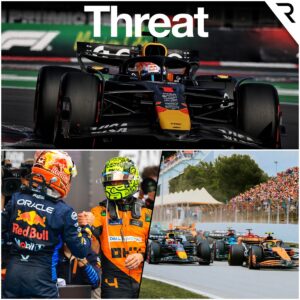The Autódromo José Carlos Pace, better known to the motorsport world as Interlagos, is not just a circuit; it is a crucible. As the Formula 1 calendar winds down to its dramatic conclusion, the Brazilian Grand Prix has once again positioned itself as the definitive high-stakes showdown, a notorious stage for championship-deciding moments and the kind of raw, unpredictable drama that makes headlines around the globe. This year, however, the promise of chaos is not just tradition—it is a statistical certainty. A perfect storm of challenging track conditions, an aggressive tire choice, and a menacing weather forecast is converging on São Paulo, guaranteeing a weekend that will be a brutal test of nerve, skill, and strategic agility. The term “Total Chaos” is not hyperbole; it is the official outlook for one of the most demanding races of the season.
The very nature of the Interlagos circuit, often reverently referred to as an ‘old school’ track, is the first layer of complexity. At a brisk 4.3 km, it is a rapid, undulating layout characterized by its significant hills and a challenging, bumpy surface. This topography is split into three distinct, demanding sections, forcing engineers into a delicate high-wire act with their car setups. The first sector, featuring the long uphill main straight and the famous Senna ‘S’ corners, is an ode to sheer engine power and straight-line speed. Conversely, the middle section is a tight, twisting maze of turns that punishes any lack of mechanical grip and demands maximum downforce. Finally, the third sector, with its sweeping final corners and long back straight, is critical for slipstreaming and creating opportunities for an overtake. Finding a setup that can excel in all three—power, grip, and aerodynamic efficiency—is fundamentally impossible, and every team must choose where to compromise, a decision that could win or lose the race before a wheel is even turned.

The Thin Air and the Cooling Crisis
Adding to the fundamental engineering challenge is the circuit’s elevation. Located high up in São Paulo, the altitude thins the air, an invisible force that presents a dual threat to the machinery. Firstly, the thinner air reduces the efficiency of the power unit, meaning engines generate less power. Secondly, and perhaps more critically, it reduces the amount of downforce the car’s wings can create. Teams must compensate by fitting larger wings than they would at sea-level tracks, which in turn increases drag, slowing them down on the straights. This forces an even tighter balance between maximizing straight-line velocity and maintaining sufficient cornering grip.
The altitude also triggers a ‘cooling crisis’ that could plague even the fastest cars. Engines and brakes struggle to dissipate heat effectively in the thin air, a worry that is magnified by the typically warm Brazilian temperatures, which are expected to hover between 25°C and 28°C. Teams are often forced into a cruel dilemma: maintain maximum engine power at the risk of overheating and a potential failure, or ‘turn down’ the power unit to manage temperatures, thus costing valuable speed on the straights. This tiny, often overlooked factor can—and often does—cost a driver a crucial tenth of a second, which is the difference between an overtake and a second-place finish in the tight midfield battle.
The Strategic Nightmare of Rubber and Rain
If the circuit itself is a demanding gauntlet, the combination of tire choice and weather forecast is the true harbinger of anarchy. Interlagos is notoriously abrasive, its rough surface pouring immense stress and heat into the tires through its fast corners. For this year’s Grand Prix, the tire supplier has opted for a softer combination: the C3, C4, and C5 compounds. This aggressive selection is designed to spice up the racing, but it comes with a terrifying strategic cost. Softer tires wear out faster, meaning that a two-stop strategy is not just likely, but almost mandatory for the main race. The driver’s capacity to manage this fast-wearing rubber—to push for pace while simultaneously being ‘kind’ to the tires—will be a defining differentiator. A car that is inherently easy on its tires will possess a monumental advantage, allowing its driver to extend stints and deploy aggressive push-laps when their rivals are struggling. This tire-saving skill, a quiet art within the cockpit, will be far more important than raw qualifying speed.
But the real ‘Wild Card’ is the weather. The forecast for the race weekend suggests a high probability of rain, especially on Saturday and Sunday. In São Paulo, ‘rain’ doesn’t mean a gentle drizzle; it means sudden, heavy downpours that can transform the track surface from a dry, high-speed ribbon to a treacherous, standing-water challenge in a matter of minutes. This meteorological volatility elevates team strategy to a fever pitch. The ability of the pit wall to react instantly and accurately—deciding the precise moment to switch from slick tires to intermediates, or from intermediates to full wets, and then back again—becomes paramount. The Brazilian Grand Prix’s history is littered with races where a sudden cloudburst completely inverted the results, stripping wins from one team and handing them to a quick-thinking rival. Pit walls will be a hive of frantic, tense activity, with meteorologists glued to radar screens, knowing that a three-second hesitation could mean the difference between a podium finish and a catastrophic retirement.

The Contenders: Strengths, Weaknesses, and the Chase for Second
With such a complex strategic landscape, the battle for victory is open, but certain teams possess distinct advantages tailored to the Interlagos challenge:
Red Bull remains the formidable benchmark. Their car package—renowned for its exceptional straight-line speed and high-speed cornering stability—is intrinsically well-suited to the circuit’s first and third sectors. Critically, their lead driver, Max Verstappen, has a proven history of mastering mixed and wet conditions. If the forecasted rain arrives, Verstappen’s unique ability to find grip where others slide grants Red Bull a powerful edge. Their strategy will rely on exploiting the car’s natural pace on the straights for crucial overtakes, while relying on their star driver to manage any weather-induced chaos.
McLaren emerges as a serious, and perhaps the closest, challenger. Their car’s strength lies in its superb balance and its speed through medium and high-speed corners, a trait that makes it perfectly suited for dominating Interlagos’s twisty middle sector. More significantly, the McLaren chassis has demonstrated a particular aptitude for managing tire heat and wear, a decisive factor on the abrasive track surface. With both Lando Norris and Oscar Piastri delivering steady, high-performance results, McLaren can deploy an aggressive, flexible two-car strategy, putting maximum pressure on their rivals across both the Sprint and the main Grand Prix.
Ferrari enters the fray as a serious dry-weather threat. Their car often excels on circuits that favour a strong front-end and superior braking performance. Should the weather hold for qualifying, Ferrari could be a dark horse for pole position. However, the ghost of past tire-wear struggles looms large. The high degradation potential on the abrasive Interlagos tarmac poses a major headache, forcing the team to be hyper-conservative with their tire strategy, which could compromise their race pace and leave them vulnerable to the two-stopping rivals.
Finally, Mercedes cannot be discounted, even if they lack the raw pace of the frontrunners. Mercedes’ greatest weapon in Brazil is their experience and strategic depth. They are a team that has historically performed brilliantly when races descend into chaos and strategy dictates the result. With two highly experienced drivers known for performing under intense pressure, they will be hoping to capitalize on any mistakes, poor pit calls, or weather-related misfortunes suffered by the Red Bull and McLaren teams ahead. For Mercedes, Interlagos is a classic smash-and-grab opportunity.

The Sprint Format and the Final Test of Nerves
Adding yet another layer of stress and unpredictability to the already volatile weekend is the presence of the Sprint race format. This means teams are limited to just a single practice session before the full-throttle Qualifying. There is no room for error; the car setup must be correct almost immediately, or the team faces the prospect of compromising both the Sprint—where valuable championship points are on offer—and the main Grand Prix. This high-risk, high-reward mini-race forces teams to weigh the reward of a handful of extra points against the high probability of a crash or damage on a difficult circuit. The quiet, intense battle among the engineers to correctly guess the optimal setup from a mere hour of data will be a vital and often unseen element of the weekend’s ultimate outcome.
With the constructors’ championship all but decided, the focus has shifted entirely to the brutal fight for the final podium positions in the Drivers’ Championship. The battles for second and third place are incredibly tight, and every single point available this weekend will be magnified. The pressure on the entire operation—drivers, pit crews, and strategists alike—is immense. Every tenth of a second in the pit lane, every single corner, and every split-second decision will be scrutinized under the harsh glare of the late-season stakes. Interlagos, with its unique demands and its history steeped in drama, is the perfect, yet terrifying, stage for this final act. What is certain is that the Brazilian Grand Prix will be a profound test of which driver and which team possesses the most complete and flexible package, proving their mettle against the ultimate chaos to claim a truly memorable victory.





